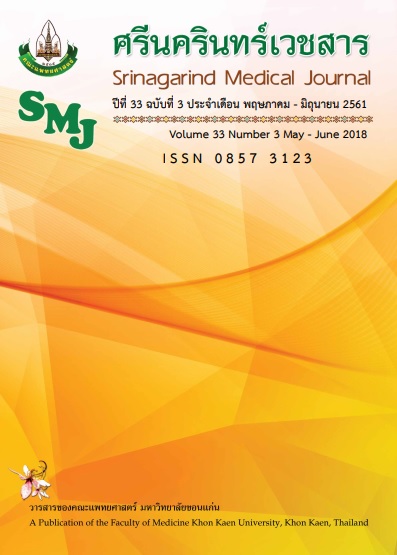Innovation: Khon Kaen Child Triage Tape in Mass Casualty Incidents
คำสำคัญ:
กัญชา, Cannabis sativa L., ประโยชน์ทางการแพทย์, โรคมะเร็งบทคัดย่อ
Background and Objectives: Triage In mass casualty incidents is difficult especially in pediatric victims, because the vital signs varies by age. In 1998, First child trauma triage tool called Pediatric Triage Tape (PPT) was developed. But we found PTT is not consistent with Thai children. So use developed a Khon Kaen Child Triage Tape (KCT tape) to predict child’s weight and test its accuracy.
Methods: Retrospective study was performed. The triage level was calculated by KCT tape in immediate group (priority 1) and non-immediate group (Priority 2 and 3) then calculated ISS in ISS ≥16 group and ISS < 16 group. The data was analyzed in 2 by 2 table Result: A total of 440 traumatic pediatric patients were triaged and calculated ISS. The data was analyzed and result show that sensitivity 14.3% (11.1-17.6; 95% CI), specificity 99.8% (99.3-100.0; 95% CI), positive predictive value 75% (71.1-79.1; 95% CI), negative predictive value 95.9% (94.1-97.7; 95% CI), Likelihood ratio + was -0.1 (-0.7 to -0.1; 95% CI), Likelihood ratio – was -0.1 (-0.7 to -0.1; 95% CI) and accuracy 95.9% (92.5-96.8; 95% CI)
Conclusions: KCT tape is proper in rule out the immediate group and need the external validation
นวัตกรรม: เทปคัดแยกเด็กขอนแก่นในกรณีผู้เจ็บป่วยจำนวนมาก
รัฐระวี พัฒนรัตนโมฬี
กลุ่มงานเวชศาสตร์ฉุกเฉิน โรงพยาบาลขอนแก่น
หลักการและวัตถุประสงค์: การคัดแยกผู้ป่วยในสถานการณ์สาธารณภัยมีความยากโดยเฉพาะผู้ป่วยเด็ก เนื่องจากค่าสัญญาณชีพที่แตกต่างกันตามช่วงอายุ ในปี ค.ศ.1998 มีการพัฒนาเครื่องมือช่วยในการคัดแยกผู้ป่วยเด็กบาดเจ็บเป็นครั้งแรก โดยใช้ความยาวหรือน้ำหนักเด็กเป็นตัวกำหนด แต่พบว่าไม่สอดคล้องกับเด็กไทย ดังนั้นผู้วิจัยจึงต้องการพัฒนาเครื่องมือในการประเมินช่วงน้ำหนักของเด็กและทดสอบความแม่นยำของเครื่องมือ Khon Kaen Child Triage Tape (KCT tape)
วิธีการศึกษา: เป็นการศึกษาเชิงพรรณนาชนิดแบบย้อนหลังในการสร้างเครื่องมือ และทดสอบความแม่นยำของเครื่องมือ ค้นเวชระเบียนและนำค่าการคัดแยกที่ได้เป็นตรวจทันที (ลำดับ 1) และไม่ตรวจทันที (ลำดับ 2-3) เทียบกับผลการคำนวณ Injury severity score (ISS) ที่แบ่งเป็น 2 กลุ่มคือ กลุ่มตั้งแต่ 16 คะแนนขึ้นไปและกลุ่มที่น้อยกว่า 16 โดยนำค่ามาวิเคราะห์ด้วยวิธีตาราง 2x2
ผลการศึกษา: จากผู้ป่วยจำนวน 440 ราย เมื่อนำมาคัดแยกระดับความรุนแรงตามช่วงน้ำหนักแล้วนำค่า ISS ที่ได้มาวิเคราะห์ ผลปรากฏว่าค่าความไว 14.3% (ช่วงเชื่อมั่นร้อยละ 95; 11.1-17.6) ค่าความ จำเพาะ 99.8% (ช่วงเชื่อมั่นร้อยละ 95; 99.3-100) ค่าทำนายผลบวกคือร้อยละ 75 (ช่วงเชื่อมั่นร้อยละ 95; 71.1-79.1) ค่าทำนายผลลบคือร้อยละ 95.9% (ช่วงเชื่อมั่นร้อยละ 95; 94.1-97.7) สัดส่วนความน่าจะเป็นบวกคือ -0.1 (-0.7 to -0.1; 95% CI) สัดส่วนความน่าจะเป็นลบคือ -0.1 (ช่วงเชื่อมั่นร้อยละ 95; -0.7 to -0.1) และความแม่นยำของเครื่องมือคือ 95.9% (ช่วงเชื่อมั่นร้อยละ 95; 92.5-96.8)
สรุป: KCT tape มีความสามารถในการคัดผู้ป่วยบาดเจ็บไม่รุนแรงออกได้ดีและควรมีการตรวจสอบจากภายนอกซ้ำ
เอกสารอ้างอิง
2. T J Hodgetts, J Hall, I Maconochie, C Smart. Paediatric triage tape. Pre-hospital Immediate Care 1998; 2: 155-9.
3. Wallis LA, Carley S. Validation of the Paediatric Triage Tape. Emerg Med J 2006; 23: 47-50.
4. Wallis LA, Carley S. Comparison of paediatric major incident primary triage tools. Emerg Med J 2006; 23: 475-8.
5. Sandell J, Maconochie I, Jewkes F. Prehospital paediatric emergency care: paediatric triage. Emerg Med J 2009; 26: 767-8.
6. Wayne Smith. (2012). Triage in mass casualty situations. [Retrieved January 15 , 2016].
Web site : www.ajol.info/index.php/cme/article/download/83802/73811
7. Kleinman ME, Chameides L, Schexnayder SM, Samson RA, Hazinski MF, Atkins DL, et al. Part 14: pediatric advanced life support: 2010 American Heart Association Guidelines for Cardiopulmonary Resuscitation and Emergency Cardiovascular Care. Circulation 2010; 122 (Suppl 3): S876–908.
8. Rosenberg M, Greenberger S, Rawal A, Latimer-Pierson J, Thundiyil J. Comparison of Broselow tape measurements versus physician estimations of pediatric weights. Am J Emerg Med 2011 ; 29: 482–8.
9. Ratrawee Pattanarattanamolee. The correlation between the predicted range of weight from Pediatric Triage Tape and the actual weight in Thai population. TCA (KKMJ). 2015 ; 39: 36-41.
10. Jitnarin N, Kosulwat V, Rojroongwasinkul N, Boonpraderm A, Haddock CK, Poston WC. Prevalence of overweight and obesity in Thai population: results of the National Thai Food Consumption Survey. Eat Weight Disord 2011; 16: e242–9.
11. Cunningham SA, Kramer MR, Narayan KMV. Incidence of childhood obesity in the United States. N Engl J Med 2014 ; 370: 403–11.
12. Trainarongsakul T, Sanguanwit P, Rojcharoenchai S, Sawanyawisuth K, Sittichanbuncha Y. The RAMA Ped Card: Does it work for actual weight estimation in child patients at the emergency department. World J Emerg Med 2017; 8: 126-30.
13. Chaiyaporn Yuksen. Performance of using Pediatric Length-Based Resuscitation Tape by Non-pediatric Medical Personnel in ED. Rama Med J 2013; 36: 23-37.
14. Baker SP, O'Neill B, Haddon W Jr, Long WB. The Injury Severity Score: a method for describing patients with multiple injuries and evaluating emergency care. J Trauma 1974 ;14: 187-96.
15. จิราพร เขียวอยู่. สถิติสำหรับประเมินคุณสมบัติเครื่องมือตรวจวินิจฉัย.ขอนแก่น : ภาควิชาชีวะสถิติและประชากรศาสตร์ คณะสาธารณสุขศาสตร์ มหาวิทยาลัยขอนแก่น, 2557: 55-7.




